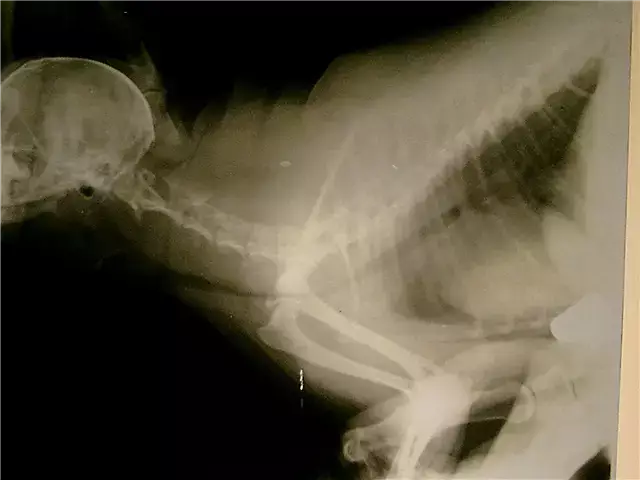- Author Rachel Wainwright [email protected].
- Public 2023-12-15 07:39.
- Last modified 2025-11-02 20:14.
Colme
Instructions for use:
- 1. Release form and composition
- 2. Indications for use
- 3. Contraindications
- 4. Method of application and dosage
- 5. Side effects
- 6. Special instructions
- 7. Drug interactions
- 8. Analogs
- 9. Terms and conditions of storage
- 10. Terms of dispensing from pharmacies

Kolme is a drug for the treatment of alcohol addiction.
Release form and composition
Dosage form - drops for oral administration, which are a clear, colorless solution with a faint smell of acetic acid (15 ml each in dark glass ampoules, 4 ampoules each complete with a dropper bottle in a plastic tray, 1 tray in a cardboard box).
Active ingredient: cyanamide, in 1 drop - 3 mg, in 1 ml - 60 mg.
Additional components: sodium acetate, glacial acetic acid, sorbic acid, water for injection.
Indications for use
Kolme is a drug for the treatment of chronic alcoholism and the prevention of its relapse after therapy.
Contraindications
Absolute:
- Kidney disease with impaired function;
- Respiratory system diseases;
- Severe liver disease;
- Severe cardiovascular disease;
- Pregnancy and lactation;
- Hypersensitivity to the drug.
In the following cases, Kolme should be used with caution:
- Epilepsy;
- Diabetes;
- Hyperthyroidism;
- Kidney disease;
- Diseases of the cardiovascular system.
Method of administration and dosage
Kolme should be taken orally.
The drug is prescribed in 12-25 drops (36-75 mg) 2 times a day at 12-hour intervals according to an individual scheme.
For the convenience of dosing, the ampoule should be opened, the solution should be poured into the bottle supplied with the kit and a dropper should be put on. When storing, the bottle must be tightly closed.
Side effects
Colme is usually well tolerated if the patient does not drink alcohol. In rare cases, tinnitus, drowsiness, fatigue, skin rash, transient leukocytosis occur.
In the case of simultaneous intake of alcohol, the following reactions may develop: a feeling of pulsation in the neck and head, blurred vision, pronounced hyperemia of the skin, tachycardia, weakness, increased sweating, difficulty breathing, chest pain, in severe cases - respiratory depression, vomiting, decreased arterial pressure, collaptoid state. The types of manifestations and the severity of reactions depend on the dose of Kolme and the amount of alcohol consumed. In severe cases, intravenous administration of antihistamines and symptomatic therapy aimed at maintaining the function of the cardiovascular and respiratory systems are indicated.
special instructions
Kolme can be used only after a thorough examination of the patient.
Each patient who is prescribed a drug should be warned about the possible consequences and complications of the therapy.
Drug interactions
Cyanamide is incompatible with drugs of the aldehyde group (paraldehyde and chloral products).
For patients who have undergone therapy with disulfiram, Kolme can be prescribed at least 10 days after its cancellation.
The simultaneous use of phenytoin, isoniazid, metronidazole and other inhibitors of aldehyde dehydrogenase can lead to an increased reaction to alcohol consumption, so such combinations are recommended to be avoided.
Analogs
Kolme's analogs are: Lidevin, ProProTen-100.
Terms and conditions of storage
Store in a place protected from light and out of reach of children. Do not exceed a temperature of 25 ° C.
Shelf life is 2 years.
Terms of dispensing from pharmacies
Dispensed by prescription.
Information about the drug is generalized, provided for informational purposes only and does not replace the official instructions. Self-medication is hazardous to health!






